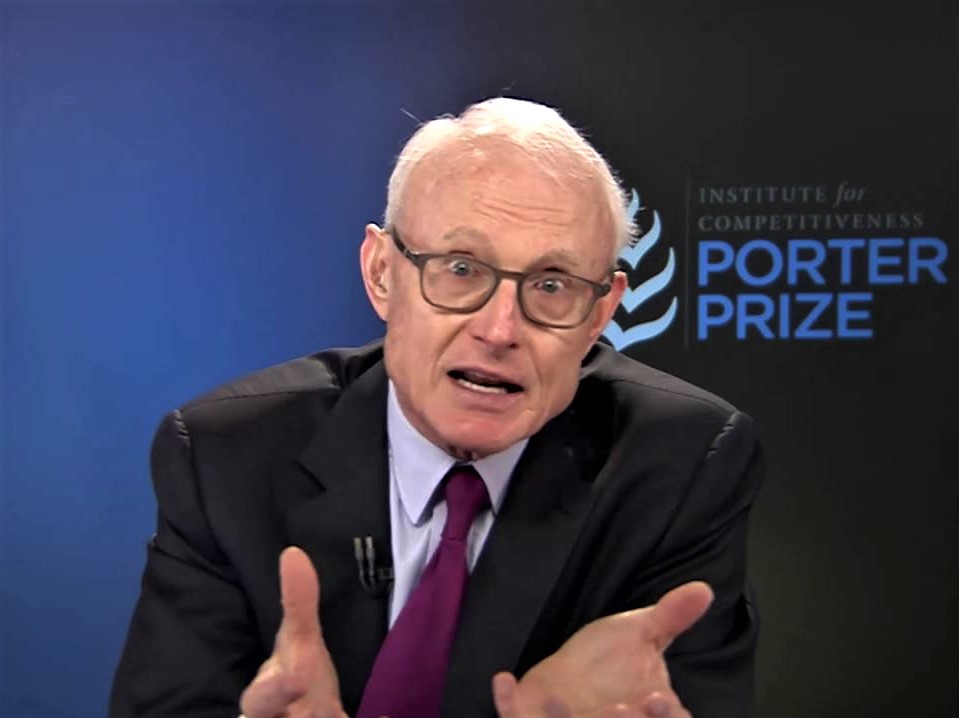US academic and thought leader Michael E Porter has a model to explain why particular industries in particular nations or localities become stars on the global stage. It’s based on the interrelationships among four key factors, hence the diamond – but government and chance play significant roles, too. More importantly, ‘success’ factors aren’t just born; they can be made.
American academic Michael Eugene Porter, born in 1947 and educated at Princeton and Harvard universities, is now the Bishop William Lawrence University Professor at Harvard Business School, where he leads the Institute for Strategy and Competitiveness. At Harvard, Porter took classes in industrial organisation economics, a field that attempts to model the impact of competitive forces on industries and their profitability, inspiring his five forces analysis framework.
The author of 18 books and numerous articles including Competitive Strategy, Competitive Advantage, Competitive Advantage of Nations and On Competition, and a six-time winner of the McKinsey Award for Harvard Business Review article of the year, Porter is the most-cited author in business and economics.
His groundbreaking theories on economics, business strategy and social causes also include the Porter hypothesis, and his ‘four corners’ and ‘diamond’ models – the latter made manifest in localised ‘clusters’ that aggregate related industries and specialised skills.
What is Porter’s diamond model?
The ‘diamond model’ is a mutually reinforcing system of four factors that (along with information, incentives and infrastructure) determine national advantage.
It is central to the thesis Porter propounds in The Competitive Advantage of Nations (1990), a book based on his studies of 10 nations that explores what makes a particular country’s industries more or less likely to be competitive on the global stage. Here, he contends that a nation’s wealth and advantage stem largely from the collective productivity of its companies and workers, supported (or otherwise) by the national and regional environment
“In [the book], I modelled the effect of the local business environment on competition in terms of four interrelated influences, graphically depicted in a diamond,” Porter explains in an article published the same year in the Harvard Business Review.
According to Porter, the influences most likely to determine whether a nation becomes internationally competitive in a specific industry or field of endeavour – say, sparkling wine production or advances in microsurgery – are:
- factor conditions – the cost and quality of inputs, including labour;
- demand conditions – the sophistication of, and intensity of demand from the local/domestic customer base;
- related and supporting industries – the extent, proximity and sophistication of local suppliers and ancillary industries; and
- the context for strategy and rivalry among businesses – the nature and ferocity of local competition.
The model also specifies two additional determinants that impact the four main influences: governmental policy and the role of chance events.
“The diamond theory highlights how these elements combine to produce a dynamic, stimulating and intensely competitive business environment,” Porter explains.
The diamond model unpacked
-
Factor conditions
Certain factors are likely to confer competitive advantage on industries in advanced economies, contends Porter. But while basic factors of production– raw materials, unskilled labour – don’t generate much in the way of competitive advantage, advanced factors – skilled labour, knowledge capital, infrastructure – give those nations that provide them a competitive edge.
Importantly, advanced factors can be fostered within a nation by both the public and private sectors. Moreover, Porter argues, nations possessing specialised factors – knowledge bases in specific fields; personnel with narrowly specialised skills, a concentration of information relating to a particular industry –are typically advantaged in that area.
So having a research institute with expertise in automation or metabolomics; an airport specially equipped to handle premium chilled produce; or a pool of venture capital keen to fund food-tech or renewable energy start-ups represents a competitive advantage to that nation or locality in that field.
Porter uses Germany’s automotive industry as an example, listing a raft of advantageous factors: notably, the country’s highly educated workforce (including numerous engineering and computer science graduates); and specialised factors pertaining to automotive production, including highly skilled workers trained via specialised local university programs and apprenticeships; and fierce domestic rivalry among the marques.
-
Demand conditions
Nations, contends Porter, gain an advantage in industries where their citizens give local businesses a clearer or earlier picture of consumer needs than international competitors can obtain.
The size of the domestic market is less important than the sophistication and intensity of demand. Sophisticated consumers demand sophisticated products, which drives greater production of such products, eventually conferring competitive advantage on that nation in the area of demand.
Equally important is early and/or rapid market saturation. Japan’s sophisticated, status-conscious and voracious home market for consumer electronics, for example, pushes companies there to innovate continually, while fierce domestic competition drives them to find new markets, underpinning Japan’s decades-long global dominance in this field.
-
Related and supporting industries
The presence of globally competitive related and supporting industries brings various advantages to industries downstream, including “efficient, early, rapid and often preferential access” to cost-effective inputs; and better access to information, ideas, insights and supplier innovations.
Indeed, having related, internationally competitive industries in one country or geographical area frequently leads to the emergence of new competitive industries in that country or locality.
-
Firm strategy structure and rivalry
Cultural elements also impact the ways a nation’s businesses are structured and managed, and differences in the goals to which businesses aspire, with domestic rivalry driving competing firms to improve, and ramping up the pressure on domestic companies to seek out markets further afield.
Governmental policy and chance events
Impacting Porter’s four determinants are two other key influences: governmental policy and chance events.
Governmental policy
Governmental policy can influence business competitiveness significantly. Regulatory measures, anti-trust laws and the like can impact a nation’s industries positively or negatively, boosting or undermining their advantage on a global level. Governments also have a key role to play in creating and/or improving factors, through actions aimed at, say, upskilling the labour force, upgrading key infrastructure or broadening the nation’s scientific knowledge base.
- Factors such as specialist education and training, and research institutions confer definitive competitive advantage – especially these days, when global standards, particularly for skilled and technical personnel, are rising continually.
- Governments can also impact demand conditions. By providing early demand for advanced, new and sophisticated products and/or services delivered by local businesses – say, by subsidising solar power for residential consumers, as Germany did; or paying for citizens’ hearing aids, as occurred in Denmark – they can boost that industry’s competitive advantage.
- A nation’s government can help its industries compete by supporting related industries alongside globally successful ones, in particular through nurturing and reinforcing ‘clusters’.
- Governments can take steps to sustain and enhance competitive advantage via a global approach to strategy, avoiding restrictions on currency, foreign investment, the inflow and outflow of skilled personnel and other actions that may impede internationalisation.
- Ensuring robust rivalry domestically requires putting strong antitrust policies in place: allowing a dominant domestic competitor rarely results in competitive advantage internationally.
Chance events
Chance can play a significant role in shifting competitive advantage, too. Developments outside the control of companies and, typically, government – fundamental technology breakthroughs, pure inventions as well as external political developments, wars, pandemics, major natural disasters and substantial changes in international demand – create discontinuities that can reshape industry structures and open opportunities for one nation’s businesses to supplant another’s.
Policy approaches that stimulate competitive advantage
Porter recommends that to support national competitiveness, governments embrace three basic principles:
- encourage change;
- promote domestic rivalry; and
- stimulate innovation.
He outlines several policy approaches for nations seeking to gain competitive advantage globally.
- Focus on advanced, specialised factor creation tied to specific industries or industry groups: “specialised apprenticeship programs, research efforts in universities connected with an industry; trade association activities; and, most important, the private investments of companies ultimately create the factors that will yield competitive advantage”, Porter says.
- Avoid intervening in factor and currency markets: Evidence shows these policies often work against upgrading of industry and the desire to seek more sustainable competitive advantage.
- Enforce strict product, safety, and environmental standards: These pressure companies to improve quality, upgrade technology and add features in line with consumer and social demands. Moreover, “when tough regulations anticipate standards that will spread internationally, they give a nation’s companies a head start in developing products and services that will be valuable elsewhere”, Porter notes, citing Sweden’s strict environmental protection standards, which have led to competitive advantage in several industries.
- Sharply limit direct cooperation among industry rivals – it reduces healthy competition and innovation, deregulate competition; and enforce strong domestic antitrust policies.
- Reject managed trade.
- Promote goals that lead to sustained investment.
“Policies that convey static, short-term cost advantages but that unconsciously undermine innovation and dynamism represent the most common and most profound error in government industrial policy,” Porter cautions.

Clustering involves collaboration for collective advantage. Credit: Shutterstock
Company strategies for gaining a global edge
Porter notes that “only companies themselves can achieve and sustain competitive advantage”. To do so, he says, they must act on the basics of the diamond model, recognising the key role of innovation.
“Competitive advantage arises from leadership that harnesses and amplifies the forces in the diamond to promote innovation and upgrading,” Porter stresses, outlining several company policy directions that support this:
- creating pressures for innovation;
- seeking out the most capable competitors as motivators;
- establishing early-warning systems that translate into “early-mover advantages”;
- improving ‘the national diamond’ by playing an active role in forming clusters and working with domestic buyers, suppliers and channels to help them upgrade and extend their own competitive advantages;
- creating specialised factors such as human resources, scientific knowledge and/or infrastructure;
- speeding innovation by siting company headquarters and other key operations in places with “concentrations of sophisticated buyers, important suppliers, or specialised factor-creating mechanisms, such as universities or laboratories”;
- welcoming vigorous domestic rivalry, which creates “sustainable competitive advantage”;
- growing internationally, rather than aiming to dominate the domestic market;
- tapping selective advantages in other nations, but not abandoning the ‘home diamond’: “relying on foreign activities that supplant domestic capabilities is always a second-best solution”;
- innovating to offset local factor disadvantages rather than outsourcing, the goal being to upgrade ‘home-base’ capabilities;
- using alliances selectively: “No company can rely on another outside, independent company for skills and assets that are central to its competitive advantage, Porter says; and
- locating your organisation’s ‘home base’ to support competitive advantage (though it can have different home bases for distinct businesses or segments, circumstances in the home nation must support innovation).
The role of clusters in achieving competitive advantage
“A cluster is the manifestation of the diamond at work. Proximity—the co-location of companies, customers, and suppliers—amplifies all of the pressures to innovate and upgrade,” says Porter.
In ‘Clusters and the new economics of competition’ (Harvard Business Review, 1998), he makes a convincing case for his thesis that several related and supporting industries existing in close geographical proximity can act in ways that magnify the influences detailed in his diamond model, fostering innovation, boosting domestic rivalry and conferring competitive advantage on businesses in the cluster. Paradoxically, despite increasing globalisation, “enduring competitive advantages in a global economy lie increasingly in local things—knowledge, relationships, motivation—that distant rivals cannot match”, he contends.
For more about clusters and how they encourage productivity and innovation, read our article on the Porter’s cluster model.
Further reading
‘Michael Porter on The Competitive Advantage of Nations’ (Harvard Business Review)
‘Determinants of National Competitive Advantage’ (Harvard Business Review)


